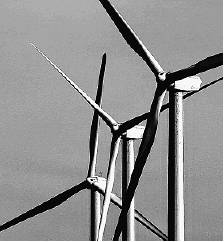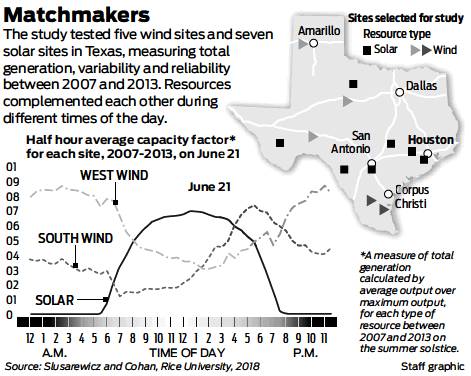Sun, wind could power state past coal
Rice study shows Texas is a natural fit for renewable energy use
By Erin Douglas STAFF WRITER
Texas might have the perfect environment to quit coal for good.
Texas is one of the only places where the natural patterns of wind and sun could produce power around the clock, according to new research from Rice University.
Scientists found that between wind energy from West Texas and the Gulf Coast, and solar energy across the state, Texas could meet a significant portion of its electricity demand from renewable power without extensive battery storage. The reason: These sources generate power at different times of day, meaning that coordinating them could replace production from coal-fired plants.
“There is no where else in the world better positioned to operate without coal than Texas is,” said Dan Cohan, an associate professor of civil and environmental engineering at Rice University who co-authored the report with a student, Joanna Slusarewicz. “Wind and solar are easily capable of picking up the slack.”
Texas is the largest producer of wind energy in the United States, generating about 18 percent of its electricity from wind. Most of the state’s wind turbines are located in West Texas, where the wind blows the strongest at night and in the early spring, when demand is low.
The resource, however, can be complemented by turbines on the Gulf Coast, where wind produces the most electricity on late afternoons in the summer, when power demand is the highest. Solar energy, a small, but rapidly growing segment of the state’s energy mix, also has the advantage of generating power when it is needed most — hot, sunny summer afternoons.
In the summer, Gulf Coast wind generation could overtake West Texas wind capacity from about 1 p.m. to 8 p.m. when sea breezes kick in, Rice research showed. From about 8 a.m. until 6 p.m., solar power average capacity also could exceed wind generation in West Texas, which increases as evening turns to night.
In the winter, winds in West Texas strengthen and generation increases, dropping off about 9 a.m., when solar energy begins to ramp up. “It’s all a matter of timing,” said Dan Woodfin, senior director of system operations at the state’s grid manager, the Electric Reliability Council of Texas.
Weather, however, remains unpredictable. Texas would still need battery storage and natural gas-fired power plants to fill in gaps when, for example, winds might slacken earlier than expected.
Coal still generates about 25 percent of the state’s power, but its share is shrinking. Since 2007, coal used in generating electricity has decreased 36 percent. Last year, Vistra Energy of Dallas shut down three coal-fired plants in Texas, citing changing economics in the power industry that make it difficult for coal to compete.
Texas has more than 20,000 megawatts of installed wind capacity, which could rise to 38,000 megawatts by 2030, according to the U.S. Department of Energy. A megawatt can power about 200 Texas homes on a hot summer day.
Solar energy, however, has developed more slowly in Texas, despite the abundance of sunshine. Texas installed about 2,500 megawatts of solar capacity in 2018.
Texas is still the sixth-largest solar energy state. Though solar energy generation capacity Texas is expected to triple over the next five years, it makes up less than 1 percent of the state’s energy mix. But the cost for utility-scale solar systems has fallen between 10 to 15 percent every year from 2010 to 2016, according to the Energy Department.
And as those costs continue to fall, energy specialists said, more investment will flow to solar projects.
“We’ll see more of a pivot toward solar in Texas,” said Josh Rhodes, a Ph.D. research associate at the University of Texas at Austin’s Energy Institute. “The price to install solar continues to fall really fast.”
Texas, and the rest of the nation, have dramatically increased reliance on renewable resources in recent years.Wind and solar are expected to provide about 11 percent of of the nation’s electricity next year, according to the Energy Department, up from 10 percent in 2018.
The flood of natural gas from the Permian Basin and other shale formations in the United States also is putting pressure on coal as generators turn to the cheaper, cleaner burning fuel and shut down more expensive coal plants, said Scott Jell, an electricity analyst with the Energy Information Administration, an agency of the Energy Department. No new coal plants are getting built in Texas or anywhere else in the continental United States.
“We’re poised on the edge of a much cleaner grid than we have today,” Cohan said. “There’s an opportunity with coal coming offline to have wind and solar step up. It’s the cheapest way to do things, whether or not you care about the environment.” erin.douglas@chron.com twitter.com/Erinmdouglas23


